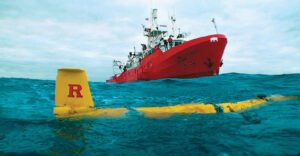EYE SPY: Information gathered from underwater gliders (below, right) could be useful in the future for Accordion and her calf (above). (NOAA Fisheries, courtesy)
An artificial intelligence tool created by Rutgers University scientists to protect North Atlantic right whales and other marine mammals could put an end to the offshore wind debate about how to keep the endangered species safe from harm’s way, if recent reports of a calf and its mother seen in a busy shipping lane between New Jersey and New York are any indication that more are to come.
The right whale, dubbed Accordion because of the propeller scars on her back that mimic the instrument, and her calf were sighted by an aircraft team from NOAA’s Northeast Fisheries Science Center on February 3, the agency said.
According to NOAA, the right whale, which was originally observed in 2011 as a juvenile, was near the shipping lanes at the Port Authority of New York and New Jersey entry. She’s never visited the customary calving grounds. We don’t know when the calf was born, but it’s her first known calf.
Rutgers University is the source.
However, NOAA experts stated that seeing a juvenile calf this far north and at this time of year is not unusual. From November 1 to April 30, accordion and her calf were spotted in the seasonal management area, which serves as a migratory and calving path. In the area, vessels 65 feet or longer are not allowed to exceed 10 knots.
All boaters and mariners from Maine to Florida can help save these whales by slowing down to 10 knots or less at times and in areas where they are likely to be present. NOAA stated that collisions with vessels of all sizes, from recreational boats to large ocean-going ships, are one of the main causes of elevated North Atlantic right whale injuries and deaths.
Since 2017, there has been an extraordinary death event among North Atlantic right whales, which have been listed as endangered for more than 50 years. Although the number of new calves in recent years has been below average, NOAA anticipates that 372 North Atlantic Right whales were alive in 2023.
Rutgers officials said earlier this week that although their AI tool was not used for last week’s finding, it is expected to assist predict endangered whale habitat and direct ships around the Atlantic coast to avoid them. The purpose of the tool is to encourage conservation efforts and appropriate ocean development while averting fatal incidents.
In order to help direct the responsible development and operation of offshore wind farms, researchers first sought to create a high-resolution model of the presence of North Atlantic right whales. However, the findings have far-reaching ramifications.
According to Ahmed Aziz Ezzat, an assistant professor in Rutgers’ Department of Industrial and Systems Engineering, these technologies are useful and would undoubtedly help everyone involved in the blue economy, including shipping, fishing, and the sustainable development of alternative energy sources. In order to accomplish our economic goals, this strategy can encourage the prudent and ecologically conscious usage of these waters while ensuring that we do little to no damage to the natural habitat of these animals.
The AI endeavor is led by Ezzat and Josh Kohut, a marine sciences professor who was appointed head of research at the School of Environmental and Biological Sciences last month.
We are using this algorithm to correlate environmental factors with a whale’s location in the water, Kohut explained. This enables us to make far better decisions regarding the potential locations of the whales. We are able to forecast the time and place where whales are most likely to be present. This will allow us to defend them by putting various mitigation methods into practice.
The computer model analyzes data from satellite-based data obtained starting in 1992, as well as all underwater gliders and autonomous, torpedo-shaped vehicles that go beneath the ocean surface of the mid-Atlantic coast. Temperature, salinity, current intensity, and chlorophyll levels are all measured by the underwater gliders.
In addition, the gliders record the underwater sounds of whales and other marine mammals, allowing them to be located in location and time, and bounce sound waves off schools of fish to determine their size. Among other things, satellite data includes measurements of fronts, water color, and sea surface temperature.
According to Kohut, we have the data, but up until now we haven’t been able to combine the two sets of whale location detections and environmental conditions at those locations. This demonstrates the effectiveness of using AI techniques to improve our capacity to forecast or estimate the whereabouts of these whales.
Meanwhile, local initiatives to save the North Atlantic Right whale include, among other things, Save LBI’s lawsuit against Atlantic Shores Offshore Wind and various federal agencies, claiming that the federal agencies mistakenly believe that no North Atlantic right whale will be harmed or killed as a result of the Atlantic Shores South project.
The group also said last month that it will petition NOAA to identify a migration corridor along the East Coast as a North Atlantic right whale’s essential habitat.
The North Atlantic right whale must migrate every year up and down the East Coast from its feeding grounds to its calving grounds in order to survive, the group said, adding that the critically endangered marine mammal’s population is still declining and that noise from offshore wind turbines in its migration path is now posing a threat to the species.
Furthermore, according to Save LBI, Atlantic Shores South will at the very least hinder, if not completely obstruct, the North Atlantic right whale’s vital habitat migration area, and its petition will demonstrate the substantial and ongoing operational noise from larger offshore wind projects. There are migration corridors off the coasts of South Carolina, Georgia, and New England.
The federal government hasn’t yet identified a crucial migration habitat between these regions, though. According to Save LBI, the whale will be able to move safely between two vital habitats if this missing link area is protected, which is equally important to guaranteeing its future. In addition to protecting other vital maritime functions like defense and navigation, establishing a wind-turbine-free zone along the East Coast will also protect the seafood, nautical, and tourism sectors of the impacted states.
Bob Stern, the president and co-founder of Save LBI, stated earlier this week that if any wind farm projects are approved, the organization will request that they be kept out of any vital habitat corridor.
Scala, Gina G.
Thesandpaper.net/ggscala

